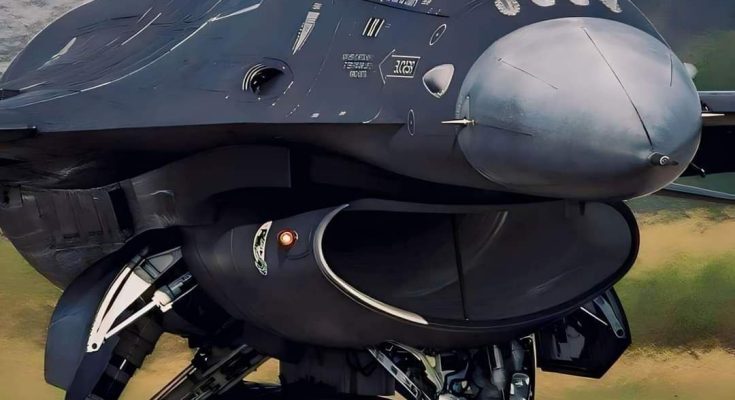The F-16 Fighting Falcon is one of the most iconic and versatile fighter jets in the world, and its long service history has solidified its place as a staple in the arsenal of numerous air forces. Developed by General Dynamics (now Lockheed Martin), the F-16 was designed to be a lightweight, multirole fighter with exceptional agility, cost-effectiveness, and combat capability. First entering service in the late 1970s, the F-16 has evolved through various upgrades and continues to serve as a crucial component of air forces worldwide.
Design and Performance
The F-16 was originally conceived as a lightweight air superiority fighter to counter Soviet aircraft during the Cold War. Its design emphasizes maneuverability and speed. The F-16 features a frameless canopy, providing the pilot with excellent visibility, and a side-mounted control stick, which allows for better ergonomics and ease of maneuvering during high-G flight.
One of the standout features of the F-16 is its fly-by-wire flight control system, which allows for extremely precise and responsive handling. This system uses electronic controls rather than traditional mechanical linkages, enhancing the aircraft’s agility and stability at both low and high speeds. This makes the F-16 especially effective in air combat, where quick, sharp maneuvers can be the difference between life and death.
The aircraft’s powerful engine and lightweight airframe contribute to its impressive thrust-to-weight ratio, enabling the F-16 to reach speeds over Mach 2 (approximately 1,500 mph or 2,400 km/h). The F-16 is also capable of performing supersonic flight without using afterburners, a feature that helps it remain stealthier and more fuel-efficient during combat.
Multirole Capabilities
One of the key reasons for the F-16’s enduring success is its multirole versatility. While it was originally designed for air-to-air combat, the F-16 has evolved into a multirole platform that can conduct a wide range of missions, including air-to-ground strikes, reconnaissance, and electronic warfare. This adaptability makes the F-16 a highly valuable asset in modern warfare, where missions often require rapid shifts in focus.
The aircraft can carry a wide variety of munitions, including air-to-air missiles (such as the AIM-120 AMRAAM), precision-guided bombs, laser-guided munitions, and cluster bombs. Its ability to carry out both defensive and offensive operations makes it a crucial component of any air force, capable of engaging enemy aircraft in dogfights, conducting precision strikes against ground targets, and providing close air support for ground troops.
Additionally, the F-16 is equipped with advanced radar systems, like the AN/APG-83 SABR radar in its modern configurations, providing it with excellent situational awareness and target detection at both long and short ranges. The aircraft can also carry external fuel tanks, increasing its combat radius and enabling it to operate in a variety of theaters, from tactical strikes to long-range interdiction.
Global Influence and Export Success
The F-16 has proven to be a global success and has been exported to more than 25 countries, making it one of the most widely used fighter aircraft in the world. It has seen action in a variety of conflicts, including the Gulf War, Kosovo, Afghanistan, and Iraq, where it has performed a variety of roles with remarkable success.
One of the reasons for the F-16’s popularity is its affordability compared to other modern fighter jets. While aircraft like the F-22 Raptor or F-35 Lightning II are priced in the tens of millions of dollars, the F-16 remains a relatively low-cost option for nations looking to bolster their air forces. It is also relatively easy to maintain, with a robust supply chain for parts and extensive training resources available.
Additionally, its multirole flexibility and interoperability with NATO forces have made it a key asset for countries that require advanced air combat capabilities without the expense of cutting-edge stealth platforms. The F-16’s modular design has also made it suitable for continual upgrades, allowing older models to be modernized to match newer technologies, further extending the aircraft’s lifespan.
Combat Record and Reliability
The F-16 has demonstrated its exceptional reliability in numerous conflicts and has become a trusted platform for a wide range of air forces. From its first combat deployment in the 1980s to its ongoing use in conflicts today, the F-16 has a reputation for being a tough, reliable, and effective fighter. Its combat record spans decades, and it continues to perform well in modern conflicts, often flying missions that require high levels of precision and quick response times.
During the Gulf War (1990-1991), the F-16 demonstrated its capability in air-to-air combat and precision strike missions, scoring significant successes against enemy aircraft and targets. It also played a pivotal role in Operation Desert Storm, providing close air support for ground troops and conducting high-speed interdiction missions against enemy forces.
The aircraft’s ongoing service in conflicts such as the War on Terror (2001-present) and other international peacekeeping missions has proven its adaptability and continued relevance.
Conclusion
The F-16 Fighting Falcon is one of the most successful fighter jets in history, known for its agility, multirole versatility, reliability, and affordability. It has been adopted by over two dozen countries and has proven itself in numerous combat scenarios. The aircraft’s combination of advanced technology, combat capabilities, and cost-effectiveness makes it an enduring choice for air forces around the world, ensuring its place as one of the most iconic and influential military aircraft ever built. With its continuous upgrades and proven combat record, the F-16 will likely remain a dominant force in modern air combat for years to come.



